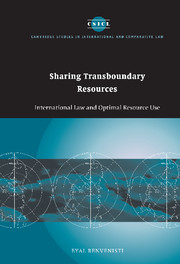Book contents
- Frontmatter
- Contents
- Acknowledgments
- Table of cases
- List of abbreviations
- 1 Introduction
- 2 The need for collective action in the management of transboundary resources
- 3 States as collective actors
- 4 The transnational conflict paradigm: structural failures and responses
- 5 Transnational institutions for transboundary ecosystem management: defining the tasks and the constraints
- 6 The structure and procedure of institutions for transboundary ecosystem management
- 7 The development of positive international law on transboundary ecosystems: a critical analysis
- 8 Efficiency, custom, and the evolution of international law on transboundary resources
- 9 Conclusion
- Bibliograhy
- Index
- CAMBRIDGE STUDIES IN INTERNATIONAL AND COMPARATIVE LAW
7 - The development of positive international law on transboundary ecosystems: a critical analysis
Published online by Cambridge University Press: 14 July 2009
- Frontmatter
- Contents
- Acknowledgments
- Table of cases
- List of abbreviations
- 1 Introduction
- 2 The need for collective action in the management of transboundary resources
- 3 States as collective actors
- 4 The transnational conflict paradigm: structural failures and responses
- 5 Transnational institutions for transboundary ecosystem management: defining the tasks and the constraints
- 6 The structure and procedure of institutions for transboundary ecosystem management
- 7 The development of positive international law on transboundary ecosystems: a critical analysis
- 8 Efficiency, custom, and the evolution of international law on transboundary resources
- 9 Conclusion
- Bibliograhy
- Index
- CAMBRIDGE STUDIES IN INTERNATIONAL AND COMPARATIVE LAW
Summary
Law at the crossroads of two clashing philosophies
This chapter examines the arrangements international law can offer or develop in response to the challenges identified in the previous chapters. Thus far, we have investigated and identified the goals and constraints involved in the management of transnational ecosystems and the causes of collective-action failure that all too often hinder states from achieving these goals. We also have considered the optimal remedies to such failures. The previous chapter delineated the necessary elements for the optimal and sustainable operation of collective institutions. The question that remains is whether states can agree to accept these basic elements and act collectively through institutions. At this juncture, we turn to international law, whose task is to provide proper incentives – both positive and negative – for states to cooperate through such institutions. In this chapter, I examine the positive law that deals with transboundary ecosystems and inquire as to what extent it reflects sound policies and to what extent – and how – it could be modified to provide the proper incentives. True to this book's confidence in the idea of endogenously evolving collective action, this chapter argues that international law can create incentives for states to cooperate. It can do so by providing states with incentives to enter into negotiations (rather than opt for adjudication of outstanding disputes) and by strengthening the institutions they may eventually form.
- Type
- Chapter
- Information
- Sharing Transboundary ResourcesInternational Law and Optimal Resource Use, pp. 156 - 200Publisher: Cambridge University PressPrint publication year: 2002

